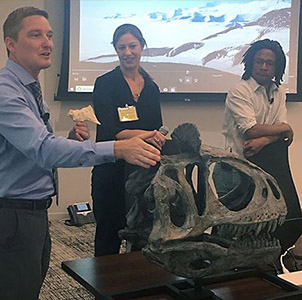|
Reconstructing Antarctica's Prehistoric Past 
National Science Foundation Posted July 17, 2018 Image: NSF photo Nathan Smith, associate curator at the Natural History Museum of Los Angeles County, holds a three-dimensional model of the brain of a Cryolophosaurus, the first carnivorous dinosaur to be discovered in Antarctica. A cast of the reconstructed skull is on the table in front of him. Smith joined Brian Atkinson (far right), a post-doctoral fellow at The University of Kansas, who specializes in prehistoric plants, and Deborah Raksany, an IMAX filmmaker, at a July 16 panel at NSF’s Alexandria headquarters to describe the challenges that faced an OPP-supported project at Antarctica’s Shackleton Glacier. The researchers investigated how creatures in Antarctica weathered a global mass extinction around 252 million years ago. The work was supported by this award: https://www.nsf.gov/awardsearch/showAward?AWD_ID=1341304 / Collaborative Research: Understanding the Evolution of High-latitude Permo-Triassic Paleoenvironments and their Vertebrate Communities
|



For USAP Participants |
For The Public |
For Researchers and EducatorsContact UsU.S. National Science FoundationOffice of Polar Programs Geosciences Directorate 2415 Eisenhower Avenue, Suite W7100 Alexandria, VA 22314 Sign up for the NSF Office of Polar Programs newsletter and events. Feedback Form |

